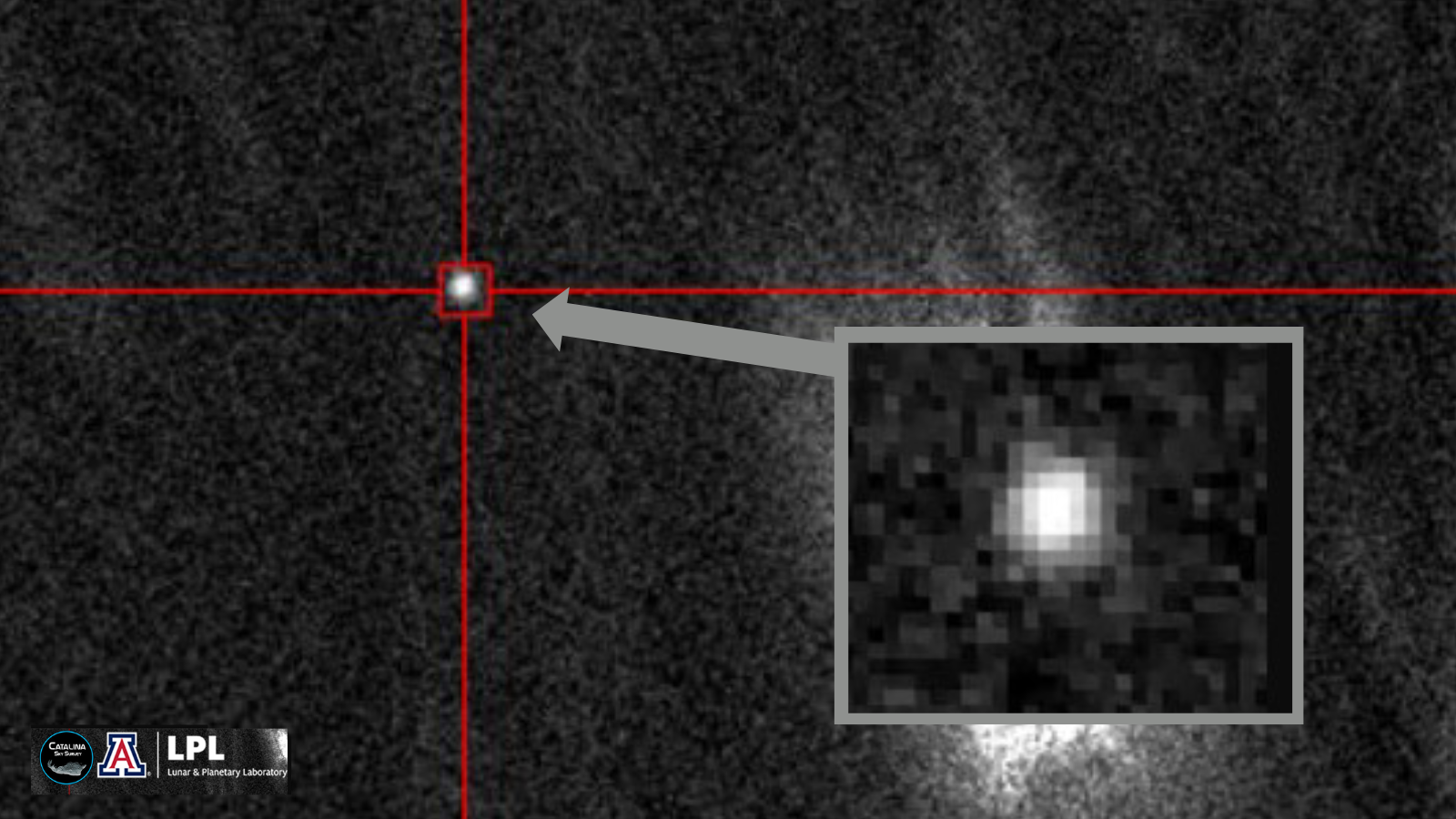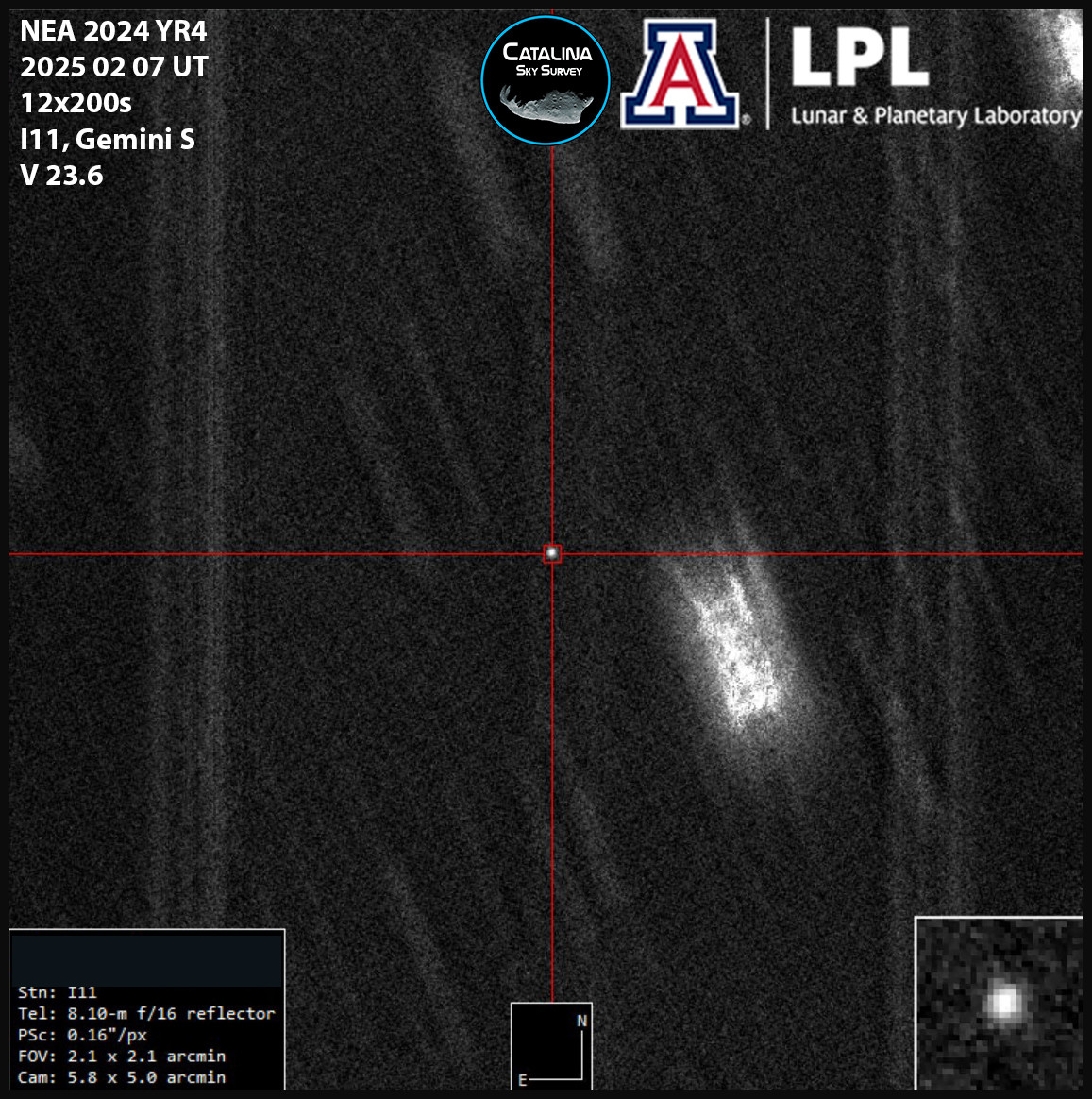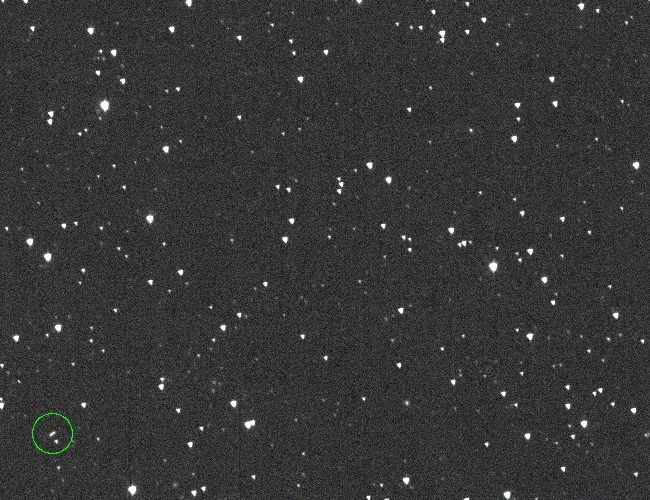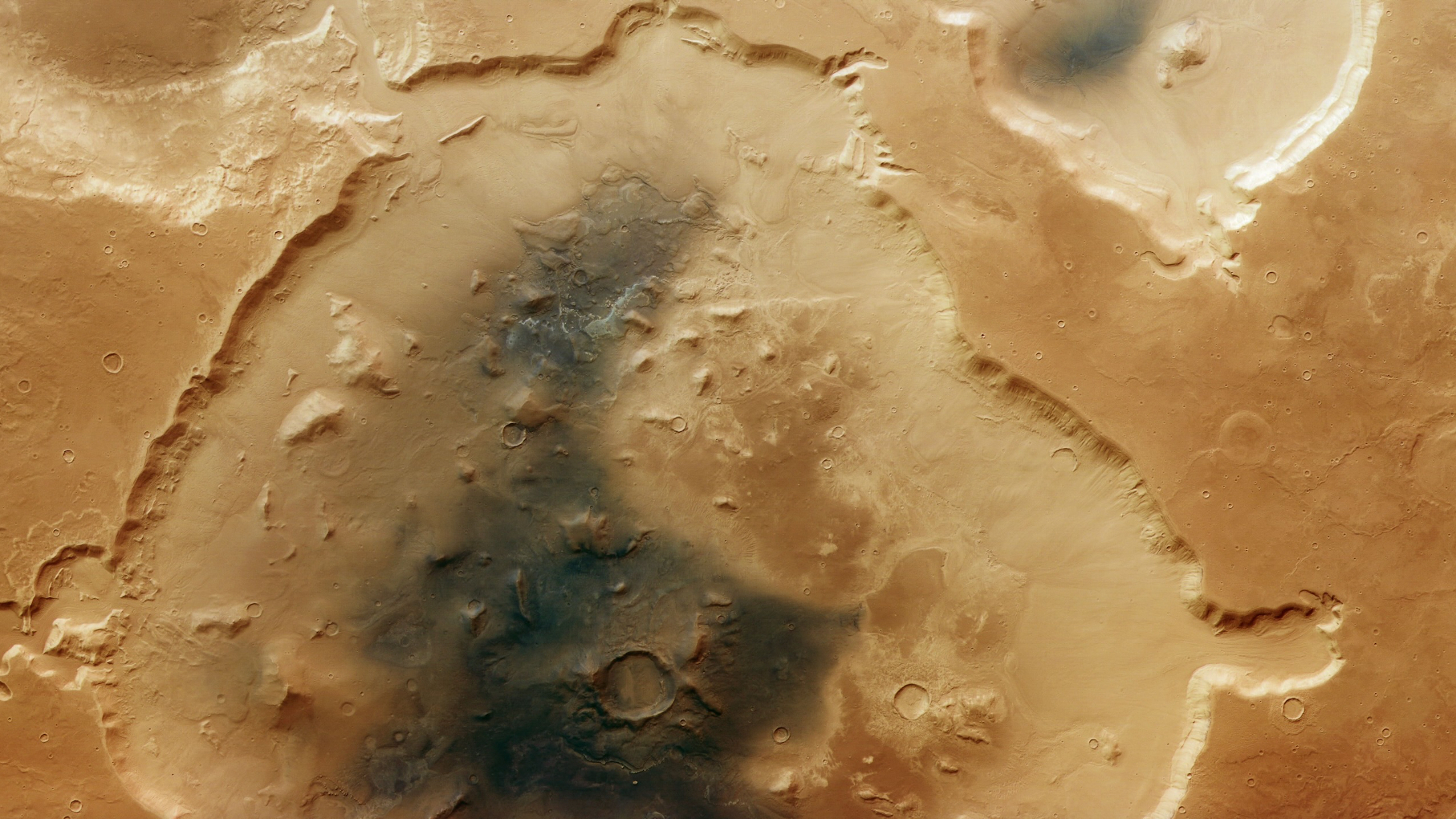What the asteroid with a 1-in-48 chance of hitting Earth in 2032 looks like (images)
"I find this asteroid to be extremely exciting! This is the last chance we have to observe the asteroid from Gemini before 2028."

It might not look like much in this image, but this is the asteroid that has made a major news impact in 2025. That's because this space rock, designated asteroid 2024 YR4, has a 1-in-48 chance of impacting Earth in 2032.
For obvious reasons, astronomers are desperate to learn as much as they can about 2024 YR4, estimated to be as large as 177 feet wide (54 meters wide). That's around as wide as Cinderella's Castle in Walt Disney World Florida is tall.
The image featured here was captured on Feb. 7, 2025 by the 8.1-meter Gemini South telescope that's located on Cerro Pachón, a mountain in the Chilean Andes. At the time the image was taken, the asteroid was around 37 million miles (59.5 million kilometers) from Earth and 130 million miles (209 million kilometers) from the sun.
"I find 2024 YR4 to be extremely exciting!" Bryce Bolin, the NASA Goddard Space Flight Center astronomer who helped capture this image, told Space.com. "Not only because of its notoriety but for the scientific potential of studying such a small asteroid in high detail.
"Only a few asteroids have been studied like this."

"We took 12 200-second long exposures in the Red band and tracked the motion of the asteroid to obtain these images," Bolin explained. "The observations were difficult for three reasons. Firstly, the asteroid was faint, requiring the use of large telescopes to observe."
Bolin explained the second difficulty surrounded the fact that 2024 YR4 was observed when the moon was 70% illuminated, meaning there was a considerable increase in sky background light compared to typical darker conditions. This made it more challenging to detect such a faint and distant object.
Finally, Bolin added that the asteroid was moving 0.26 arcseconds per minute, which necessitated careful tracking with Gemini South to avoid trailing losses.

This isn't the first image of asteroid 2024 YR4. The asteroid was first discovered by the NASA-funded Asteroid Terrestrial-impact Last Alert System (ATLAS) on Dec. 27, 2024.
Soon after its discovery, the asteroid raced to the top of NASA's Center for Near Earth Objects Studies (CNEOS) Sentry impact risk table. The asteroid has remained there ever since, with the odds of impact in seven years climbing.
Asteroid hunter David Rankin has been tracking 2024 YR4 since its discovery. He recently reassured Space.com's readers by explaining that the increase in impact odds was expected. Rankin added that those odds are also expected to drop soon when the orbit of this asteroid is better understood.
Get the Space.com Newsletter
Breaking space news, the latest updates on rocket launches, skywatching events and more!
There are more Gemini South images of 2024 YR4 in the pipeline, but as the asteroid is currently heading away from Earth, it might be a while until we get a really good look at this space rock — from the ground at least.
Bolin explained that 2024 YR4 will appear to fade until around mid-March, making it rather difficult to detect from the ground. The asteroid will become visible to ground telescopes in mid-2028 as it reapproaches Earth.
"Therefore, this is the last chance we have to observe the asteroid from Gemini before 2028," Bolin concluded.
Space-based telescopes may have a little more fortune tracking this space rock until then. The James Webb Space Telescope (JWST) is set to join this quest in March of this year.
Join our Space Forums to keep talking space on the latest missions, night sky and more! And if you have a news tip, correction or comment, let us know at: community@space.com.

Robert Lea is a science journalist in the U.K. whose articles have been published in Physics World, New Scientist, Astronomy Magazine, All About Space, Newsweek and ZME Science. He also writes about science communication for Elsevier and the European Journal of Physics. Rob holds a bachelor of science degree in physics and astronomy from the U.K.’s Open University. Follow him on Twitter @sciencef1rst.
-
Unclear Engineer I am wondering how the probability of impacting Earth is calculated.Reply
From the descriptions in previous articles, it sounds like there is a circle (probably actually more like an ellipse) of uncertainty inside which the asteroid will pass through Earth's orbit. If Earth is inside that circle, then there is a probability that it will hit Earth.
But, how is that probability calculated? Is the probability distribution inside the circle assumed to be uniform across the entire area? Or, is there a peaked probability distribution with the peak being at the best estimate track for the asteroid?
If the latter, what is the current best estimate track - does it hit Earth or not? If not, how much is the best estimate miss distance, based on current info? -
Zephyrus001 I doubt that the distribution density function is modeled uniformly across some elliptical surface. I say this because you'd need some method for establishing confidence bounds in the first place. There are back-of-the-napkin ways of doing this, but even then you'd probably use a bivariate normal distribution if you had no better information than that. I'd wager that NASA or one of its affiliates has a high fidelity n-body model of the solar system that has all the ephemeral data plus all the uncertainties on that ephemeral data. To this they'd add the ephemeral data they've captured on this asteroid. Other model parameters might consider other nuances like outgassing from differential heating. From there, they'd run a Monte-Carlo simulation that drew randomly on all the model parameters and their uncertainties. They might use a sampling technique like Latin-Hypercube to aid the model in converging quickly and reducing model confidence bounds. Assessing probability is just counting the number of impacts divided by the number of total simulated scenarios. You could process the data and compute the peak in the probability distribution or even fit a target distribution if you wanted. There is too much domain knowledge required to know for sure, but if you put a gun to my head, I'd say the miss distance distribution would be Rayleigh-like.Reply -
Unclear Engineer Reasonable guesses. I am hoping for somebody who knows the actual process to give us a clue, here.Reply
But, I would expect that there would be some hesitancy to tell the public any more details about best estimate paths, both because those will probably change a lot, and because miss distances might be or get very small as the uncertainty values get shifted around, even thought he final result might be much less scary.
Can't hurt to ask. But, at this point, NASA employees have a lot of "distractions" and probably don't feel safe attracting any attention to themselves. -
COLGeek As you guys have discussed, it would be fascinating to see the modelling on this. Much like hurricane/weather forecasting, there is certainly a high level of uncertainty. To UE's point, that uncertainty likely creates a bit of risk in terms of public release.Reply
Many would misinterpret/misunderstand the model and lose their minds (outrage/fear/extreme reactions are the norm now, unfortunately no matter how off base the issue really is).
Using hurricane terminology, there must be a rather large "cone of uncertainly" with this model/prediction. -
Zephyrus001 If you want to read more details about NASA's Sentry System, it's available. There are even papers to read if you want to dig in more. I'd caveat this saying that the in the primer linked below, they are describing the whole monitoring process which would be too cumbersome and resource intensive to do by brute force Monte Carlo - as they explain themselves. My guess - and I realize I'm not "in-the-know" is that this asteroid is a "special case" that is getting its own dedicated Monte Carlo. The main point I got from this is that their parameter estimation technique is MLE based on minimizing residuals of predictions less observations over time. NASA Sentry PrimerReply -
Unclear Engineer OK following the links in Zephyrus001's post, I think I have the NASA info on 2024 YR4, here: https://cneos.jpl.nasa.gov/ca/ . You will have to first change the settings from "near future" to "future only" and "update data" before you then put "2024 YR4" in the "Search" box. That should give you just one listing for 2024 YR4. Then, clicking on that, you can get the currently calculated parameters. Unfortunately, I don't seem to be able to copy that screen's address to provide a direct link, here.Reply
Looking at the current info for 2024 YR4, I see "CA Distance Nominal" of 0.00105 AU and "CA Distance Minimum" of 0.00001 AU, which correspond to about 100,000 miles nominal and 930 miles minimum. If I am reading this correctly, that 930 miles is a direct hit on the 8,000 mile wide earth with a radius of about 4,000 miles to compare to that 930 mile minimum. But, I am not clear at this point whether the Earth's radius is or is not already subtracted. I don't think it is subtracted, because it then would have zero probability of a hit, if I correctly understand how NASA computes that probability.
Anyway, it looks like the best estimate is a miss by about 100,000 miles. Which is not very good click bait.
So, many thanks again to Zephyrus001 for that link. -
Unclear Engineer But, the click bait continues: https://www.uniladtech.com/science/space/nasa/nasa-engineer-exact-locations-asteroid-could-hit-earth-713413-20250214Reply
". . . likely strike anywhere between northern South America, across the Pacific Ocean, southern Asia, the Arabian Sea, and sub-Saharan Africa."
Which makes it look like the uncertainty in its time of impact is nearly a full day of Earth's rotation.
While I don't find this particular asteroid to be scary, I am paying attention to how the process is being developed to deal with one that will, sooner or later, become a serious problem for at least some locations on our planet.
We still don't know enough to make good decisions about how to respond to mitigate a real impending strike. So, much of the effort now is to figure out what we will need to know and how to learn it. Knowing where and when near Earth asteroids will come close to Earth gives us time to develop missions that can take advantage of their proximity to study them in detail. -
Charles Bell H47Vicksburg The world's largest single-aperture optical telescope is the 10.4m Gran Telescopio Canarias which submitted observations of asteroid 2024 YR on 2024-Jan-13 when the object was near mag 21 in g band. This telescope is on the list of 8-10 m class telescopes in the IAWN observing plans. Its HiPERCAM instrument can reach mag 28 in g' band with 4-hour integrations under sub-arcsecond seeing conditions. The HiPERCAM instrument observes in multiple optical bands simultaneously (u', g', r', i', z'). Gran Telescopio Canarias is a 10.4 meter reflecting telescope located at the Roque de los Muchachos Observatory on the island of La Palma, in the Canary Islands, Spain. This telescope was used in September 2024 and with others to confirm the lunar origin of minimoon asteroid 2024 PT5 published February 2025. This telescope observed Didymos in 2017 to examine the ejecta from the DART spacecraft impact.Reply
ESA photo of Gran Telescopio Canarias
=AZUsZvliaKs_TM9WVsCmsCnjSS_h-1GC2mI_kIOPWmUQHukcLNBbv5jkroSyn_I2WIUdpv2YKohB8qqZIZ61VqQrbAuHaiTqdRD-D9JpzDcLxZfmRu47re6x9Ov5K79_ATMBb0UGtp70HxjypRIvGtS9o1Q1DQLyBqtccJ9QDAFX4OIQcL6RDV2Mctsyfyscepo&__tn__=EH-R']https://scontent-dfw5-1.xx.fbcdn.net/v/t39.30808-6/480463583_1063573625784113_7419047344380151974_n.jpg?_nc_cat=111&ccb=1-7&_nc_sid=127cfc&_nc_ohc=Mogn6hjsRDEQ7kNvgHUgX5W&_nc_oc=AdjUSNvnhHMrVVictMLbsPrwaj2KYHodKttzAsuUw5zB4bWrEMK45U0aQemM4fgE8oE&_nc_zt=23&_nc_ht=scontent-dfw5-1.xx&_nc_gid=ARRHYpZgpzLqjKcj65-R3Gt&oh=00_AYCdGzVPIigqCDjAIRhXeQeS-0yb29RRa8q2Jg6KOPFAxg&oe=67B8F782 -
Charles Bell H47Vicksburg Today's Daily Orbit update posts new observation by Z23 – Nordic Optical Telescope, La Palma andReply
H01 – Magdalena Ridge Observatory, Socorro. These observations extend the observation arc of 2024 YR4
to 416 total observations over interval: 2024 12 25.304941 – 2025 02 17.207112
Look for new CNEOS Sentry and ESA Risk List data later today.
MPEC 2025-D07 : DAILY ORBIT UPDATE (2025 February 17)
Z23 –Nordic Optical Telescope (NOT) is a 2.56-m telescope located at the Spanish "Roque de los Muchachos" Observatory (ORM), La Palma, Canarias, Spain.
H01 – Magdalena Ridge Observatory is a .4-meter telescope in Socorro County, New Mexico -
Charles Bell H47Vicksburg Latest Sentry update of 2025-Feb-17 shows a small increase in cumulative impact probabilityReply
Sentry: Earth Impact MonitoringImpact Probability (cumulative)2.6e-2
Alternate Representations for Impact Probability = 2.6e-22.6% chance of Earth impact
1 in 38 odds of impact
97.4% chance the asteroid will miss the Earth
Expect to see it change every day that the Minor Planet Center posts a daily orbit update with additional observations.
If you want to know the latest, check JP CNEOS Sentry or ESA Risk List
https://cneos.jpl.nasa.gov/sentry/
or
https://neo.ssa.esa.int/risk-list
Davide Farnocchia from JPL made a presentation at the 2025 Feb 4 IAWN meeting in Vienna with more info and slides. It contains the overall plan in case the impact probability does not become negligible by April 2025, i.e., if impact probability reaches 10% threshold for terrestrial planning.
